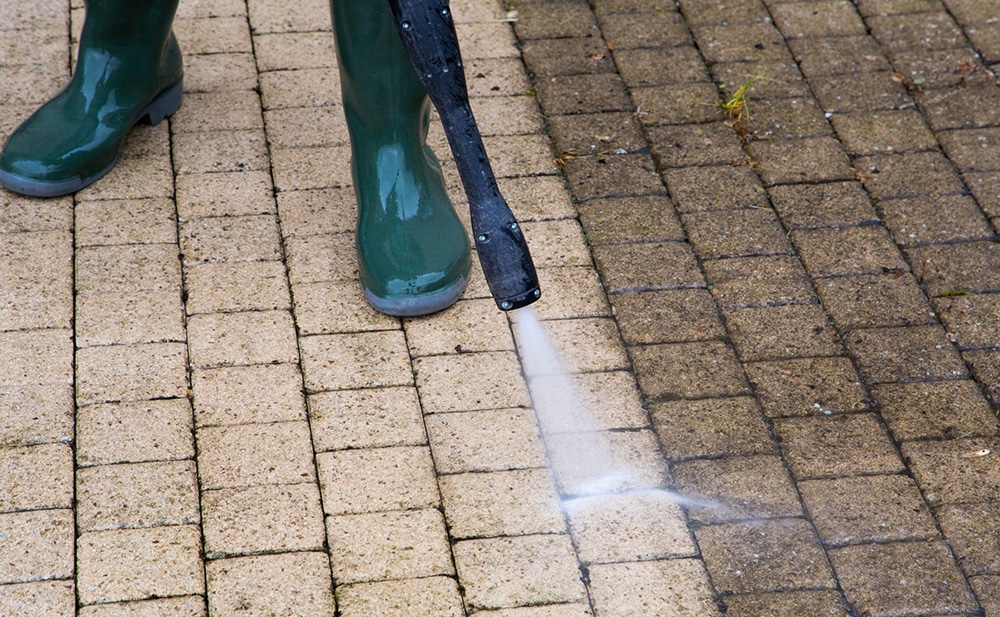
Brick patios have a timeless charm and a rustic beauty that few other surfaces can match. But if you’ve noticed weeds sprouting between the joints or grime making your bricks look dull, it might be time to bring out the power washer. However, loose mortar or crumbling joints can turn a routine cleaning into a patio-wrecking disaster. 😬
So how do you clean your brick patio effectively and safely when dealing with loose mortar? Let’s walk through some smart, damage-free power washing tips. 🧽💦
🧱 The Problem with Loose Mortar
Loose or deteriorating mortar in brick patios is often the result of:
- Age and weathering 🌧️☀️
- Water penetration and freezing cycles
- Movement in the ground beneath
- Inadequate drainage or construction flaws
Power washing without caution can blast out mortar, dislodge bricks, or even damage the underlying base, leading to costly repairs.
✅ What to Do Before You Start Washing
1. Inspect the Patio Closely 🔎
Walk the entire surface and identify:
- Cracked mortar joints
- Wobbly or uneven bricks
- Areas with visible moss, weeds, or mold
Take photos if needed so you know where to focus (or avoid).
2. Patch or Repoint the Mortar (If Needed) 🧱🧰
If the mortar is severely damaged, consider repointing before pressure washing. Use a jointing tool and fresh mortar to refill and stabilize weak joints.
3. Remove Weeds or Moss by Hand 🌿
Don’t rely solely on pressure—pull weeds and scrape moss manually to avoid gouging the surface later with high water pressure.
💧 Choosing the Right Tools
- PSI rating: Keep pressure under 1,500 PSI for brick
- Spray tip: Use a 25° or 40° wide-angle tip
- Surface cleaner: Ideal for even pressure and less erosion
- Brushes: A stiff-bristled broom or patio brush for prep work
- Cleaning solution: A non-acidic, brick-safe detergent
Avoid narrow or turbo nozzles—they can dig out mortar like a chisel. 🚫
Browse Amazon Here For Top Rated Power Washers And Accessories
🧪 What Cleaning Solutions Are Best?
Choose biodegradable, non-corrosive cleaners specifically formulated for masonry. Look for options labeled:
- “Safe for brick and mortar”
- “Non-acidic”
- “Biodegradable”
Popular options include:
- Simple Green Oxy Solve
- Wet & Forget Outdoor
- Custom DIY: 1 part vinegar to 4 parts water (for light jobs)
Apply the solution using a low-pressure setting and allow it to dwell 5–10 minutes.
Browse Amazon Here For Biodegradable Pressure Washing Detergents
🪣 Step-by-Step Power Washing Process for Loose Mortar Patios
- Pre-wet the patio to avoid detergent soaking directly into dry, brittle mortar.
- Apply cleaning solution evenly with a low-pressure sprayer.
- Let it dwell for 5–10 minutes to loosen stains, grime, or algae.
- Gently scrub with a brush in areas with heavy buildup.
- Rinse using low to moderate pressure, keeping the spray at a 45° angle and at least 12–18 inches from the surface.
- Work in sections, rinsing from the highest point down to prevent streaking.
⚠️ Common Mistakes to Avoid
❌ Using a turbo nozzle or high-pressure stream
❌ Holding the wand too close to joints
❌ Blasting at loose bricks or corners
❌ Starting without inspecting the integrity of the patio
Even a small oversight can blow out mortar or shift bricks, leading to tripping hazards or drainage problems.
🛠️ Post-Wash Maintenance
Once clean, check the patio again for:
- Newly exposed or eroded mortar
- Settling bricks
- Standing water or puddling
You can follow up with fresh mortar touch-ups or a brick sealant to help prevent future erosion and reduce weed regrowth. 🧱✨
👷 When to Hire a Pro
If your patio has widespread mortar damage, is sloping unevenly, or contains high-end materials like antique brick, consider hiring a pressure washing expert who specializes in masonry cleaning. Professionals have:
- Variable pressure machines
- Soft wash systems
- Proper detergents
- Masonry repair experience
🧼 Final Thoughts
Brick patios can absolutely be power washed—but only when you treat them with care. With loose mortar in the mix, think of it less like blasting away grime and more like gently reviving history.
Stick to low pressure, smart technique, and some good old-fashioned prep work, and you’ll enjoy a beautifully refreshed patio without damaging the structure beneath it. 🧱💧🌞
Browse Amazon Here For Top Rated Power Washers And Accessories



